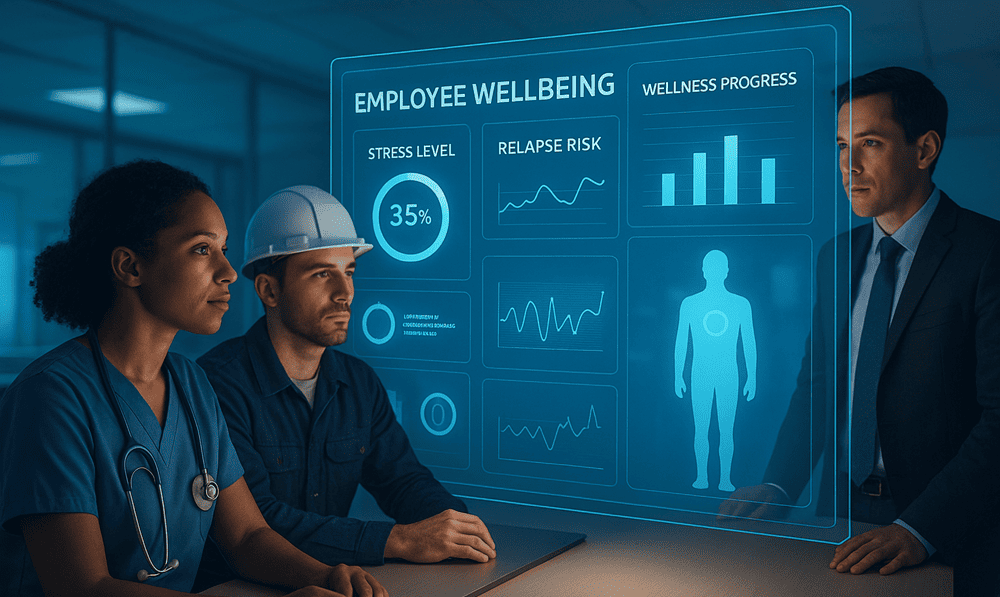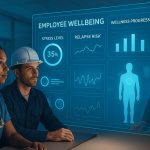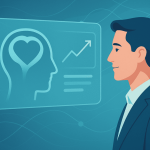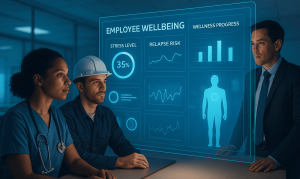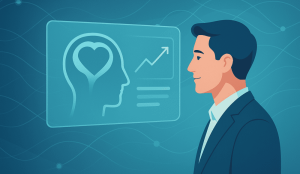In industries where pressure, long hours and high stakes are everyday realities, the risk of substance misuse, behavioural addiction and relapse rises significantly. For leaders in sectors like healthcare, emergency services, finance, tech and manufacturing, the stakes are not just individual but organisational. This is where AI for addiction prevention becomes a strategic pillar, not just a wellness overlay.
In this article we’ll explore how smart technologies are being used for digital relapse prevention, how behavioural health AI and substance monitoring AI are being applied in workplaces, and why initiatives like AI for workplace recovery and stress related addiction matter for high-stress industries.
We will also touch on how to embed the right mindset and culture to support this technology-driven approach.
The challenge: high-stress industries and addiction risk
High-stress industries face several overlapping pressures: tight deadlines, unpredictable shifts, emotional intensity, heavy workloads, and organisational change. These conditions contribute to elevated risk for behavioural and substance addiction.
- Recent research found that nearly one in three workers admitted to on-the-job substance use or addictive behaviours; 48% said they turned to addictive behaviours as a way to cope with workplace stress.
- In the U.S., about 9 % of all employed adults (13.6 million workers) live with a substance use disorder (SUD) and just 1 % receive treatment annually.
- Employers are increasingly aware: many report performance issues and higher absenteeism linked to addiction-related challenges.
From a leadership perspective, these issues affect productivity, talent retention, reputation and employee wellbeing. Addressing them means moving beyond reactive treatment and into proactive prevention.
Why “AI for addiction prevention” makes sense now
The term “ai for addiction prevention” refers to using artificial intelligence tools and systems to predict, monitor, intervene and support individuals at risk of addiction—before a crisis occurs.
Here are key reasons this approach is timely:
- Machine learning models are increasingly accurate in identifying risk factors for addiction, relapse or behavioural patterns tied to substance misuse.
- Traditional addiction care has been reactive; AI enables more real-time, continuous support and monitoring.
- In high-stress industries, there’s growing acceptance of digital tools to support employees’ mental and behavioural health, making it feasible to incorporate substance monitoring and digital relapse prevention.
- Organisations can link such technology with broader programmes of corporate wellbeing AI to gain deeper insights into workforce health, risk patterns and return-to-work readiness.
Key use-cases of AI in addiction prevention
Here are practical examples of how AI technology is being used in this domain, with relevance for high-stress workplaces:
1. Risk assessment & early warning
AI algorithms analyse diverse data sets — medical history, behavioural signals, wearable biometrics, shift patterns — to identify employees who may be at elevated risk of addiction or relapse. For example:
- Using wearable and mobile data to detect changes in sleep, activity, stress patterns.
- Predictive analytics based on previous behavioural health episodes, workload spikes or stress events.
By adopting such early intervention AI tools, organisations can shift from “after the fact” to “ahead of the curve”.
2. Monitoring & support interventions
Once risk is identified, AI-driven platforms can support monitoring and behavioural reinforcement. Examples:
- Chatbots or virtual assistants delivering behavioural prompts, check-ins or coping skills when triggers are detected.
- Real-time intervention: e.g., wearable devices signalling elevated heart rate + low sleep + high workload → send notification to employee/coach.
- Systems integrating with EAPs (Employee Assistance Programs) or wellness portals to offer supportive pathways.
3. Relapse prevention frameworks
In industries where relapse has high cost (healthcare worker errors, safety incidents, compliance violations), digital relapse prevention is critical. AI solutions can:
- Alert practitioners or supervisors when patterns re-emerge.
- Offer tailored “micro-experiences” (brief nudges) based on individual behaviour.
- Track progress over time, generate risk-scores and support longitudinal prevention.
4. Workplace recovery and reintegration
For employees who have returned to work after treatment, workplace recovery AI can support sustainable integration:
- Monitor absenteeism patterns, fatigue or stress signals that may indicate relapse risk.
- Coordinate with leader coaching AI tools so that managers receive cues when team members may require additional support.
- Link with absenteeism reduction AI programmes that identify health-related absenteeism trends and trigger preventive actions.
5. Stress-related addiction analytics
Given that stress is a major trigger for addiction, high-stress industries stand to gain from stress related addiction AI:
- Systems track stress indicators (physiological, behavioural, digital-footprint) and correlate them with substance-use risk.
- Organisations embed stress-management systems as part of broader stress management AI and recovery frameworks.
What leadership should ask when implementing AI for addiction prevention
When adopting these systems, corporate leaders should focus on a clear framework:
| Area | Key Questions |
| Strategy & alignment | Does the initiative align with our organisation’s broader wellbeing strategy? How will it integrate with existing programmes (EAP, HR, occupational health)? |
| Data & privacy | Are we collecting the right data for substance monitoring AI without violating privacy or trust? How is consent managed? |
| Ethics & bias | Have we assessed algorithmic bias, fairness, unintended consequences (e.g., over-surveillance)? |
| Workflow & integration | How will risk alerts flow into practical action (coaching, manager alerts, wellness support)? Can our managers leverage leader coaching to respond appropriately? |
| Measurement & ROI | What metrics will we track (relapse rates, absenteeism, productivity, error rates)? Are we linking to absenteeism reduction initiatives? |
| Culture & adoption | Are employees comfortable engaging with these systems? How do we build trust and eliminate stigma? The link to healthcare worker wellbeing is critical here. |
| Sustainability | Are we designing for long-term use (prevention, not just one-off)? How will we evolve the assistance program over time? |
Case in point: A scenario in healthcare
Consider a large hospital system where staff are under intense pressure: long shifts, high emotional load, regulatory demands. They decide to pilot an AI for addiction prevention system.
- Phase 1: Introduce wearable trackers + mobile app to monitor fatigue, sleep, stress patterns.
- Phase 2: Use machine learning to identify nurses at risk of substance misuse or behavioural relapse.
- Phase 3: Link with behavioral health AI chatbots offering coping strategies, and integrate with supervisor dashboards driven by leader coaching AI.
- Phase 4: Monitor outcomes: reduced absenteeism, fewer safety incidents, improved healthcare worker wellbeing scores.
Because stress-related triggers are flagged earlier, the institution prevents incidents, fosters trust, and reduces cost associated with treatment or turnover. The link between prevention and organisational performance becomes clear.
Key benefits and possible challenges
Benefits
- Early detection means fewer crises and less disruption.
- Improved workforce safety, productivity and retention.
- Better integration of wellness, behavioural health and operations.
- Data-driven insights allow more precise resource allocation.
Challenges
- Data privacy and employee trust: ensuring confidentiality matters.
- Risk of over-surveillance and stigma if tone is wrong.
- Technology must complement—not replace—human engagement (coaches, supervisors, peer networks).
- Cost and organisational change management: embedding new systems takes time.
Practical steps for corporate leaders
Here’s a suggested roadmap:
- Identify your risk profile – Understand stressors, industry-specific triggers, workforce size and culture.
- Define measurable objectives – E.g., reduce relapse-related absenteeism by X%, improve wellness-score by X in 12 months.
- Choose the right tech partner – One experienced in workplace recovery ai and digital relapse prevention tools.
- Design user-centric rollout – Engage employees, build trust, communicate how the system supports them (not penalises them).
- Pilot with a cohort – e.g., high-stress division or role, gather feedback and outcomes.
- Integrate with existing programmes – Link to AI for wellbeing, EAP, supervisor training.
- Scale and monitor – Continuously measure metrics, iterate, address privacy/ethical issues, refine workflow.
- Promote culture change – Encourage open dialogue about addiction, normalise support, highlight that prevention is an investment in workforce health.
Conclusion
For leaders in high-stress industries, ignoring addiction risk is no longer viable. The financial, operational and human costs are too high. Leveraging ai for addiction prevention offers a forward-looking strategy that blends technology with human support, elevating workforce wellbeing and organisational resilience.
When executed thoughtfully, respecting privacy, ethics, culture and human touch, the result is healthier employees, stronger teams and better business outcomes.
If you’d like help exploring how to adopt this in your organisation, or how to integrate it with your existing corporate wellbeing AI or assistance program, let’s discuss next steps.

